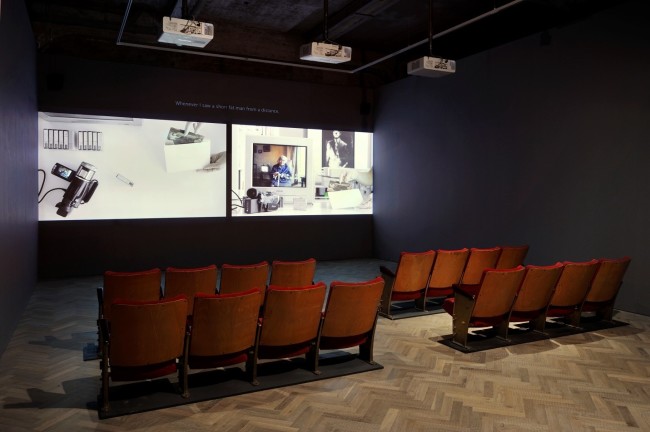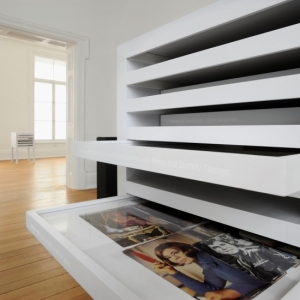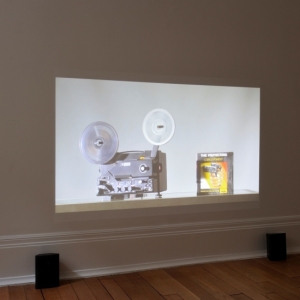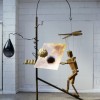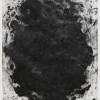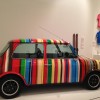Encountering the work of Lebanese artist Akram Zaatari in a commercial London gallery is somewhat peculiar. Zaatari’s work may be more comfortable in institutions such as the Tate, MOMA or the Centre Pompidou. However, the installations, photographs, and films on display at Thomas Dane Gallery succeed in conveying the driving ideas behind Zaatari’s oeuvre as well as providing more conventionally commercial pieces such as the massive Hӧfer-esque Objects of Study/Studio Sheherazade (2006).
Split over two gallery spaces on Duke Street St. James’, the exhibition explores the process of archiving vernacular Lebanese photographs and film. A founding member of the Arab Image Foundation (A.I.F.), an institution dedicated to preserving photographs from the Arab world, Zaatari continues his work with Studio Sheherazade, the commercial studio of photographer Hashem el-Madani. Zaatari’s work has revolved around the materials and archive of el-Madani for many years, yet as this exhibition demonstrates, there is more artwork to be created from it.
Twenty Eight Nights and a Poem (2006) is an installation comprised of wooden cabinets containing photographs, a Super 8 projection, and HD videos on ipads, kindles and projections. The display occupies most of the 11 Duke St. location. Many of the individual pieces show projections and even a c-print being made. In this installation Zaatari reflects upon his own work of archiving el-Madani’s photographic career as well as the work of the A.I.F.
In A Photographer’s Tools, displayed on a wall-mounted kindle screen, el-Madani’s tools are laid out on a table above a ruler. From this almost anthropological approach it is made clear that the recording of such objects is entirely over-the-top. The preservation and study of these objects can only go so far in telling a story; it lies with artists, writers, and citizens to create and preserve their history.
The centerpiece of the exhibition is On Photography People and Modern Times (2010), the show’s title piece. The complex film evokes Zaatari’s signature themes of the archive, story-telling through vernacular photographs, self-reflexivity, and documentation. It is composed of two screens: the left screen being an almost bird’s eye view of the action on the right. Interviews are played on a TV screen from a connected camcorder while a pair of gloved hands removes vernacular photographs from archival envelopes and mattes. The interviewees (interestingly not identified) discuss stories and memories associated with the photographs. The near sterile treatment of the photographs, along with personal stories about them, clearly demonstrates the photographs’ re-contextualisation.
While Zaatari and the A.I.F. strive to preserve such photographs and their stories, in doing so something of the photographs is lost. Photographs belonging in family albums, stuck in the frames of mirrors, or in wallets are instead in archival, stark-white envelopes and mattes, treated with the utmost care and kept away from bright lights and human touch. Perhaps such treatment of the photos is necessary for their preservation, but it requires that they be wholly divorced from their original function.
The underlying narrative of the film (and the exhibition itself) is war and conflict. Among other founding members of the A.I.F. such as the artist Walid Raad and the writer and video artist Jalal Toufic, there is a sentiment of replacing what was lost in fifteen years of civil wars in Lebanon through the preservation of remaining artifacts, in this case, vernacular photographs. Indeed, many of the stories told in On Photography People and Modern Times revolve around wars and conflict. Though the photographs discussed in the film are generally happy, the interviewees often discuss how war touched on their lives. In the work of the A.I.F. and Zaatari one has the sense of trying to recover something that was lost forever, or to recreate it. Perhaps the stories that were lost in the conflicts can never be recovered, but new histories and memories are being created through Zaatari’s archival work. However, through the emphasis on the careful treatment of vernacular photographs, it becomes clear that this history cannot accommodate the emotional impact of what has been lost.
